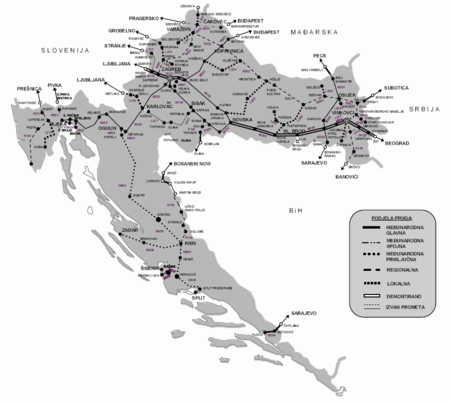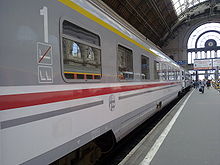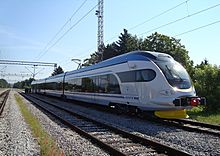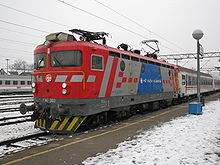- Croatian Railways
-
Hrvatske željeznice 
Type Government-owned Industry Rail Transport Founded 1991 Headquarters Zagreb, Croatia Products Rail Transport, Rail Construction, Services Website Official website (English) Croatian Railways (Croatian: Hrvatske željeznice, HŽ) is the national railway company of Croatia. It was formed after the dissolution of Yugoslavia and Yugoslav Railways.
Croatia is a member of the International Union of Railways (UIC). The UIC Country Code for Croatia is 78.
Contents
Railway network
The Croatian railway system consists of 2,974 km of rails (of which 248 km is double track). 1,228 km is electrified - 41.3%. (End of 2004).
There are several major railway routes in the country:
- (coming from Ljubljana, Slovenia) from Dobova via Zagreb, Slavonski Brod, Vinkovci to Tovarnik (and on to Belgrade, Serbia)
- there is a connection in Strizivojna-Vrpolje towards Osijek
- from Zagreb to Osijek via Koprivnica
- from Zagreb to Rijeka
- from Zagreb to Split
- from Zagreb to Sisak - the shortest but very important
- from Zagreb to Varaždin
There are also other routes to Slovenia, Hungary, Bosnia and Herzegovina and Serbia.
The railways are in urgent need of modernization. Following the break-up of Former Yugoslavia, there has been minimal investment in railway infrastructure right across the country. Many important routes are still not electrified, are single track, have high grades and meandering sections - ultimately leading to slow speeds.
The network has been improved over the last ten years, with the effect of an increased maximum speed on the Zagreb-Novska-Vinkovci line. There are sections where the speed limit has been raised from 80 km/h to 120 km/h and even 160 km/h. Railway modernisation is set to be extended further with a national 'railway investment plan' (with funding totalling over 18 billion HRK through to 2012.
Dobova-Tovarnik line (International corridor X)
The railway line between Dobova and Tovarnik, operating the length of Croatia east-west via Zagreb, is the country's most important rail line, and part of the Pan-European corridor X. It is also the most advanced and busiest, being completely electrified and consisting mostly of double tracks. In a longitudinal manner it crosses Croatia's northern regions Slavonia, Posavina and the Greater Zagreb Region, connecting the most economically developed towns in Croatia with each other. The route is as follows
- Dobova (Croatian border with Slovenia)
- Zagreb
- Sesvete (track split towards Sisak (electrified))
- Dugo Selo (track split towards Botovo (electrified)) (This is planned as the future corridor 5b)
- Ivanić Grad, Kutina
- village Banova Jaruga (again track split towards Virovitica (non-electrified))
- Novska (track split backwards towards Sisak (electrified))
- Nova Gradiška
- the combined station for the villages Nova Kapela-Batrina (track split towards Požega, and via Pleternica towards Našice (non-electrified) )
- Slavonski Brod
- combined station for the villages Strizivojna-Vrpolje (two track splits: towards Osijek (currently non-electrified) and towards Slavonski Šamac (electrified, Croatian border to Bosnia and Herzegovina))
- Vinkovci (four track splits: towards Osijek, Vukovar, Županja and Brčko in Bosnia and Herzegovina, before the Croatian war of Independence, this was one of the biggest East European junction stations, for both passengers and freight)
- Tovarnik (Croatian border with Serbia)
At Vinkovci the track splits and branches towards: Županja, Vukovar, both non-electrified. The connection towards Osijek was severely damaged in the Croatian War of Independence.[1] Repairs began in 2003 and in December 2008 the line was reopened.
Ogulin-Knin line
The Ogulin-Knin line, also known as the "Lička pruga", or Lika line is part of the railway connection between Zagreb and Split. As of 2007[update], this line is being heavily upgraded with many sharp bends and grades removed in order to allow tilting trains to travel at nearly full speed on most parts of the track. Reducing travel time from Split to Zagreb by around a third, to 5–6 hours. This track was not intended as the shortest distance between Zagreb and Split. The line via Martin Brod which forms the border with Bosnia, has not been reopened to passenger traffic since the recent conflict.
The problems faced are that as the line was constructed a long time ago and contained many curves (often in difficult terrain), services were slow and speeds severely restricted. The modernisation has involved rebuilding complete sections of track, straightening many curves, by repositioning and by renewing track and enabling for higher speeds. Electrification of the line is not scheduled for the near future.
Most of the stations are abandoned because the Serbian front has covered this area. Local trains are only functioning between Ogulin-Vrhovine, two couple per day. Between Vrhovine-Knin, there is no local passenger transport, even if some stations are in good condition (e.g. Medak, Malovan, Plavno). ICN tilting trains only stop in Gospic and Gracac. Some stations will recently be renovated or rebuilt (Lovinac, Gospic), but the Croatian Railways doesn't plan restarting local passenger transport.
International corridor V
The fifth Pan-European corridor has two branches in Croatia, the "b" and "c" branch.
Coridor Vb enters Croatia in Botovo, and runs to Zagreb. The part from Zagreb to Rijeka should become part of this corridor, as soon as the extension towards Rijeka is built.
Corridor Vc is a Pan-European railway line, running north to south within Croatia. It enters Croatia at Beli Manastir on the border with Hungary, and runs through Osijek to enter Bosnia and Herzegovina in Slavonski Šamac. It enters Croatia again in Metković, in the very south-east of Dalmatia, where it ends at the Ploče harbour. The line crosses the Dobova-Tovarnik line in Strizivojna-Vrpolje. The line is currently being heavily modernised in order to revitalize Ploče's harbour.
The part from Strizivojna-Vrpolje towards Slavonski Šamac is fully electrified, and recently the modernised catenary has been put into operation. The passenger traffic scheduled from Vinkovci to Slavonski Šamac (now performed by electrical power) is still fragmented. The remaining part from Strizivojna-Vrpolje to region of Osijek (heart of the region Slavonia) is scheduled to be electrified, as soon the general overhaul of the line track is completed, after which operating speeds will finally be raised to 160 km/h (100 mph). The line will stay single track.
The Vinkovci-Osijek line
The Vinkovci-Osijek line was, before the dissolution of Yugoslavia, one of the most heavily used branch lines of Croatia, linking two regional centres. The line allowed speeds of up to 120 km/h. After the war, only about 10 km of the 35 km line remains preserved. Most of the track was removed by Serb forces, who used it used as barricades, and for other war purposes.
The reconstruction of this vital route was finally finished in 2008. Test driving with a measuring vehicle has been successful, and speeds of 60–80 km/h have been reached. Test train went on maiden voyage on 12.12.2008. The regular revenue service restarted on 14.12.2008.
The "Unska pruga" route
The route called Unska pruga (lit. the Una track) that connects Zagreb and Split along the Una river valley was once an integral part of the Yugoslav Railways railway system. Today, this route remains largely unused, since much of the route virtually runs over the border between Croatia and Bosnia and Herzegovina, crossing it multiple times, on the section between Knin and Bihać.
Although this route is largely well preserved and electrified at 25 kV/50 Hz (making it compatible with the Croatian electrification system), administrative problems concerning the many border crossings cause this route to be used only for limited freight traffic services. The designated border crossing along the line between the two countries is at the town of Martin Brod.
Network connection problems
There are some rail network connection problems, which have historical causes. When Croatia was part of Yugoslavia, the rail network was consistently connected and managed by Yugoslav Railways. As the Yugoslav constituent states demerged, important rail links were severed.
Istria
Istria has no direct connection through Croatia. Currently, all rail operates through Slovenia, though this could be solved with a tunnel north of Rijeka.
Dubrovnik
The Dubrovnik area is again a special case. Dubrovnik and its surrounds are an exclave, divided by the small Bosnian Neum corridor. There has never been a direct rail link through Croatia to Dubrovnik.
Historically, the Dubrovnik region has been developed through sea travel, but a large 760mm narrow-gauge rail network was constructed in the early 20th Century (when Dalmatia was under Austrian control, and as part of the complex Balkan politics of the time [2]). This route, however, was from Dubrovnik via Čapljina to Mostar and Sarajevo[3][4] (since 1991 both in Bosnia) rather than to Split and Zagreb in Croatia. In 1967 the line from Sarajevo as far as Čapljina was upgraded to standard gauge, and extended to terminate at the nearby port town of Ploče, some miles from Dubrovnik and beyond the Neum corridor, handling freight via Bosnia. Today, Croatian Railways operates a short service between Ploče and the border town of Metković, which sees daily passenger traffic.
The route to Dubrovnik beyond Čapljina was closed in 1975 by the Yugoslav Government, acting on the advice of foreign transport consultants. This was in spite of the attractive scenery of the route which has been compared to Switzerland's narrow gauge network. Proposals in 1985 to reopen the route were unsuccessful, and today the route closely follows the Bosnian border for several stretches with several crossings, making reopening and operation difficult.[5][6]
Power systems
The original decision in former Yugoslavia was to use 3 kV DC electrification for the railway network. This was performed on the Rijeka-Zagreb line, which due to the mountainous Gorski kotar region had a need for more powerful trains than the traditional diesel powered ones.
Beginning with the modernisation of the Zagreb-Belgrade line an electrification system of 25 kV/50 Hz was used. Electrification on other lines in Croatia was then made exclusively 25 kV/50 Hz. Later, the majority of the Zagreb-Rijeka line was re-electrified to 25 kV/50 Hz, but there is still a part that is 3 kV DC. Consequentially a power system break still exists at Moravice. HŽ is now considering the purchase of dual-voltage locomotives, as an alternative to full re-electrification of 3 kV DC tracks.
All railway power systems in Croatia are exclusively of type overhead catenary.
Rolling stock
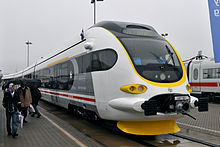 The newest HŽ acquisition - HŽ series 6112, a regional multiple unit built by Končar, Zagreb at InnoTrans 2010
The newest HŽ acquisition - HŽ series 6112, a regional multiple unit built by Končar, Zagreb at InnoTrans 2010 Main article: Rolling stock of the Croatian Railways
Main article: Rolling stock of the Croatian Railways- 3 kV electric locomotives
- HŽ 1061.0
- HŽ 1061.1
- 25 kV electric locomotives
- HŽ 1141.0
- HŽ 1141.1
- HŽ 1141.2
- HŽ 1141.3
- HŽ 1142.0
- Diesel locomotives
- Shunting diesel locomotives
- HŽ 2132.0
- HŽ 2132.1
- HŽ 2132.2
- HŽ 2132.3
- Leased for testing: quad voltage Siemens Dispolok ES 64 F 4
- HŽ 1241.0
- Electric trainsets:
- HŽ 6011.0
- HŽ 6111.0
- HŽ 6112.0
- Diesel trainsets: 3 classes (including ICN)
- HŽ 7121.0
- HŽ 7121.1
- HŽ 7122.0
- HŽ 7123.0
Due to lack of passenger train garnitures, sometimes some endorsed classes are still used, like 7021.0 (two left) and 7221.0 (as branch-line or backup garniture).
Tilting trains
In 2004, 8 modern Bombardier RegioSwinger tilting trains called "ICN" (short for InterCity Nagibni; Tilting InterCity) from the German branch of Bombardier Transportation were delivered to Croatian Railways. These trains are normally deployed on the mountainous route between the two largest Croatian cities, route Zagreb - Split, but are also sometimes on the InterCity routes in the continental part of the country. In the case of the Zagreb-Split route, this offers passengers a much more comfortable and time-saving journey with regard to previous trains whose journey took 8 hours, whereas the tilting trains take less than 5 and a half hours, and are more quiet and better equipped as well.
However, tilting trains' safety and their possible technical incompatibility with the conditions of the Croatian railroads are highly disputed after the 2009 Rudine train derailment, an incident that occurred on July 24, 2009 when 6 passengers were killed and 55 were injured in the crash.[7] Almost 3 years before this fatal derailment, on November 24, 2006, there was another accident in which train's engineer was killed. Tilting train had crashed with the lorry on the railroad crossing that had no ramp and warning lights.[8] Out of 8 trainsets that were introduced in 2004, two are written off. It's very likely that the tilting train service will be reduced as there are not enough trainssets any more to serve all scheduled ICN trains and destinations.
Renumbering
In 1993 HŽ renumbered all their vehicles. This results in some confusion to the relation to their previous numbers. All other companies, which have been formed after dissolution of JŽ have kept the original numbers.
Croatian speed record
The current rail speed record in Croatia is 185 km/h. The record was set on the line between Novska and Nova Gradiška. The run was performed in order to demonstrate the possibilities offered by the JŽ 1 442 train class (now HŽ 1 142 train class). Despite being over 25 years old the 1 142 remains the fastest train in operation with Croatian railways.
The track used was built to withstand speeds of 200 km/h, which is the technical limit of class 1 142. However, for safety reasons, the maximum speed of the HŽ 1 142 in regular service is set to 160 km/h.
Future developments and projects
- Building a new line between Bjelovar and Zagreb (Railway line Gradec-Sveti Ivan Žabno).
- Suburban rail traffic around Zagreb is to be fully renovated and reorganised. Some local lines previously shut down will be reactivated, and a link to Zagreb Airport has been approved and announced by Zagreb authorities. New EMUs and DMUs have been ordered from Croatian manufacturer KONČAR.
- 2009 or 2010 will see the opening of a newly-constructed line to Samobor though following a different route to the previous line. The line will use new rolling stock and help alleviate the trouble currently encountered by those wishing to travel between the two cities
- Suburban rail traffic around Split is to begin (has already begun on a small scale). See: Split Suburban Railway
- Corridor 5c will be upgraded to allow an operating speed of 160 km/h. This has already been completed between Osijek and Slavonski Šamac.
- Corridor 5c will be completely electrificated (date still unknown)
- Dual power engines will be purchased. Some tests with trains from various manufacturers, mostly Siemens Eurosprinter electric engines, have been performed already.
- The Rijeka-Zagreb line will have a common power system
- Revitalization of the Osijek-Vinkovci line recently started, and the line will support maximum speeds of 120 km/h (100 km/h in practice). Since this line was in a badly damaged state the reconstruction will be done in 2 phases. Phase 1 is only the necessary signalling (track crossing signalling through traffic signs only). Due to this fact and the current corresponding Croatian laws, traffic must commence very carefully, and probably trains will have to stop on every crossing and then speed up again. Due to excess costs in phase 1, phase 2 will be deploy automatic track-road protection devices on all crossings, which will finally allow full nominal line speed.
High-speed rail line
A fully electrified line connects Rijeka with Zagreb (though with power system break from 3kV DC to 25kV/50 Hz AC at Moravice), and onwards towards Koprivnica and the Hungarian border, as part of the European 5b corridor. A transportation bill, to be passed by the Croatian Parliament, will see the start of construction of Croatia's first high-speed rail line, following the aforementioned 5b corridor, enabling theoretical speeds of 200 km/h, with an average journey speed of 160 km/h. The last economic indications (new signalling system beyond 160 km/h would be to expensive) show that 160 km/h will probably be used in practice (at least in the beginning). The plan consists of updating the existing track between the Hungarian border and Karlovac to a double track line and building a completely new track between Karlovac and Rijeka. The line's complete length will be 269 km, 61 km shorter than the current line. Construction on the new line will start in Autumn 2008[9] and will be completed by 2013.[10] The speeds of this line will enable a trip from Rijeka to Zagreb in an hour, as opposed to the current four hours.
The initial route plan is described on this link: Initial proposed solution
Initially, the planned maximum operational speed of the line was to be 250 km/h, but was cut down to 200 km/h in later stages in order to save several billion kunas. Signalling will be brand-new and the line will be entirely devoid of level crossings. The line will be built primarily to serve the huge amount of goods that enter Europe in the Port of Rijeka and are then distributed all over Central and Eastern Europe.
In the end, 160 km/h will most probably be used after all, at least in the beginning. Signalling systems for higher speed will be too expensive and cross the available budget. If this line itself shows to be promising, the signalling upgrade to higher speeds will happen. As of now, Croatian Railways does not possess any vehicles which could drive beyond the speed of 160 km/h. Only one locomotive class can originally go 180 km/h by specification (test-run passed at this speed), but it is limited to 160 km/h, due to security reasons and regulations. In order to really have some speeds greater than 160 km/h in future, leased stock or new purchases are necessary. For freight transport, such speeds are unnecessary. Only passenger transport can benefit on long term from this.
Unofficial long term projects
- More usage of the flagship ICN trains (the newest HŽ stock acquisition), also on Zagreb-Našice line (over Nova Kapela-Batrina and Pleternica), additionally to currently running Zagreb-Osijek over Strizivojna-Vrpolje train and to Varazdin. This is the latest news, as announced. Ridership on existing ICN lines proved to be full success. The ICN Zagreb-Osijek, Zagreb-Varaždin and Zagreb-Split ICN lines are almost always at 100% ridership capacity.
- Reelectrification and bringing back the destroyed catenary and signals on Novska-Sisak and integration in the full pre-war length and conversion to former known Zagreb-Novska alternative route, also speed increase.
- A new, just few kilometers long connection route (branch line) connecting two rail routes around Bjelovar is planned a long time, and, when build, will shorten travel times from Bjelovar to Zagreb (now done over Križevci). This will be the first entirely original railroad line in Croatia in many years.
- Plans to upgrade the Dobova-Tovarnik (Corridor X) to double track at the full length (if the freight traffic increases to pre-war amounts or above that) and higher speeds (above 160 km/h) (talked about since long time). Most of the track damaged sections between Novska and Tovarnik is completely renewed after the Croatian war of independence. This route is the most probable candidate for a track above 200 km/h in the current status, as it is the most modern route, and double track in mostly excellent condition exists currently between shortly before Zagreb and Dugo Selo, and between Novska and Vinkovci. The part of double track existing after Vinkovci to Tovarnik is still being reconstructed, though only one track is currently functioning at reduced speed. This route is protected by security systems (St. Andrew's crosses and ramps) in the whole length. Near Zagreb, and Vinkovci there are even fully separate level crossings with roads. The rest is also mostly separate level crossing. Only the signalling system and overhead catenary would need some adaptations.
- The Osijek-Vinkovci line is planned to be electrified after reopening, if justified. Before the war related closure and heavy damage in 1991, it was one of few profitable branch lines. With new changed circumstances (this is now a direct and shortest connection between European corridor Vc and corridor X), it would be economically justified to electrify it, as shortest link between the two corridors towards eastern Europe.
- Sisak-Kutina-(Lipovljani), a new short highcapacity railway stretch for the speed of 250 km/h. This will be a link between the corridor X branches over Sisak and Kutina.
Some technical data
- Currently maximum allowed speed on parts of the network: 160 km/h
- Train protection system used (where applicable): INDUSI (a stripped down derivative of German system)
- Signaling system: at sight only, automatic block protection (on mainlines and where applicable)
Rail links with adjacent countries
- Same gauge:
See also
References
- ^ Vinkovci: Nakon 17 godina vlakom u Osijek[dead link]
- ^ "A SHORT HISTORY OF THE RAILWAYS IN DALMATIA 1876-2007". http://members.a1.net/elob/ada/dalmatia.htm. Retrieved 31 May 2010.
- ^ "Dubrovnik to Sarajevo in 1965 by Charlie Lewis - Page 1". http://www.penmorfa.com/JZ/dubrovnik2.html. Retrieved 31 May 2010.
- ^ "Dubrovnik to Sarajevo in 1965 by Charlie Lewis - Page 2". http://www.penmorfa.com/JZ/dubrovnik2.html. Retrieved 31 May 2010.
- ^ "From Sarajevo to Dubrovnik in 1967 by Dave Sallery - Page 1". http://www.penmorfa.com/JZ/one.htm. Retrieved 31 May 2010.
- ^ "From Sarajevo to Dubrovnik in 1967 by Dave Sallery - Page 2". http://www.penmorfa.com/JZ/two.htm. Retrieved 31 May 2010.
- ^ 14:27 (2009-07-24). "Nagibni vlak kod Ka¹tela iskoèio iz traènica: Za nesreæu krivo protupo¾arno sredstvo? - Vijesti.net". Index.hr. http://www.index.hr/vijesti/clanak.aspx?id=443114. Retrieved 2011-05-03.
- ^ 14:27 (2006-11-24). "U sudaru HŽ-ovog vlaka i kamiona poginuo strojovođa - Vijesti.net". Index.hr. http://www.index.hr/vijesti/clanak/u-sudaru-hzovog-vlaka-i-kamiona-poginuo-strojovodja/333207.aspx. Retrieved 2011-05-03.
- ^ Kalmeta talks about infrastructural projects in current 4-year plan
- ^ "New projects in Croatian Infrastructure". Pfaffrail.googlepages.com. http://pfaffrail.googlepages.com/NizinskiKalmeta.pdf. Retrieved 2011-05-03.
External links
- Official website (English)
- Map
- Map with all railway stations
- Forum about Croatian Railways - also with an English subforum
- Croatian stock list
- Croatian withdrawn stock list
- History of Yugoslawian railways, which is the predeccessor of Croatian Railways
Rolling stock of the Croatian Railways Diesel locomotives: Electric locomotives: DMUs: EMUs: HŽ 6011 • HŽ 6111 • HŽ 6112
Withdrawn or not active: Curiose: Predecessor company was Yugoslav Railways (JŽ), and part of its rolling stock was also used in Croatia. Rolling stock of the Yugoslav Railways Steam locomotive classes: 
Diesel locomotive series: Long obsolete series: National railway companies of Europe List of railway companies · Rail transport by country · Railway companies by country  HSH •
HSH •  HYU1 •
HYU1 •  ÖBB •
ÖBB •  ADY1 •
ADY1 •  BŽD/BČ •
BŽD/BČ •  SNCB/NMBS •
SNCB/NMBS •  ŽFBH2 and ŽRS3 •
ŽFBH2 and ŽRS3 •  BDŽ •
BDŽ •  HŽ •
HŽ •  ČD •
ČD •  DSB •
DSB •
 EVR •
EVR •  VR •
VR •  SNCF •
SNCF •  SR1 •
SR1 •  DB •
DB •  TrainOSE •
TrainOSE •  MÁV •
MÁV •  IÉ •
IÉ •  FS •
FS •  KTŽ1 •
KTŽ1 •  HK/KŽ4 •
HK/KŽ4 •  LDZ •
LDZ •  LG •
LG •
 CFL •
CFL •  MŽ •
MŽ •  CFM •
CFM •  ŽCG •
ŽCG •  NS •
NS •  NSB •
NSB •  PKP •
PKP •  CP •
CP •  CFR •
CFR •  RŽD •
RŽD •  ŽS •
ŽS •  ŽSR •
ŽSR •  SŽ •
SŽ •
 RENFE •
RENFE •  SJAB •
SJAB •  SBB/CFF/FFS •
SBB/CFF/FFS •  TCDD1 •
TCDD1 •  UZ •
UZ •  BR5 / NR6 / NIR7
BR5 / NR6 / NIR71Country partly in Asia • 2For the Federation BH • 3For Srpska • 4State with limited recognition • 51948-2000
6Created in 1999, owned by ATOC • 7For Northern IrelandRail transport in Europe Sovereign
states- Albania
- Andorra
- Armenia
- Austria
- Azerbaijan
- Belarus
- Belgium
- Bosnia and Herzegovina
- Bulgaria
- Croatia
- Cyprus
- Czech Republic
- Denmark
- Estonia
- Finland
- France
- Georgia
- Germany
- Greece
- Hungary
- Iceland
- Ireland
- Italy
- Kazakhstan
- Latvia
- Liechtenstein
- Lithuania
- Luxembourg
- Macedonia
- Malta
- Moldova
- Monaco
- Montenegro
- Netherlands
- Norway
- Poland
- Portugal
- Romania
- Russia
- San Marino
- Serbia
- Slovakia
- Slovenia
- Spain
- Sweden
- Switzerland
- Turkey
- Ukraine
- United Kingdom
- Vatican City
States with limited
recognition- Abkhazia
- Kosovo
- Nagorno-Karabakh
- Northern Cyprus
- South Ossetia
- Transnistria
Dependencies
and other territories- Åland
- Faroe Islands
- Gibraltar
- Guernsey
- Jan Mayen
- Jersey
- Isle of Man
- Svalbard
Other entities Categories:- Transport companies of Croatia
- Rail transport in Croatia
- Companies established in 1991
- Government-owned transport companies
- (coming from Ljubljana, Slovenia) from Dobova via Zagreb, Slavonski Brod, Vinkovci to Tovarnik (and on to Belgrade, Serbia)
Wikimedia Foundation. 2010.

